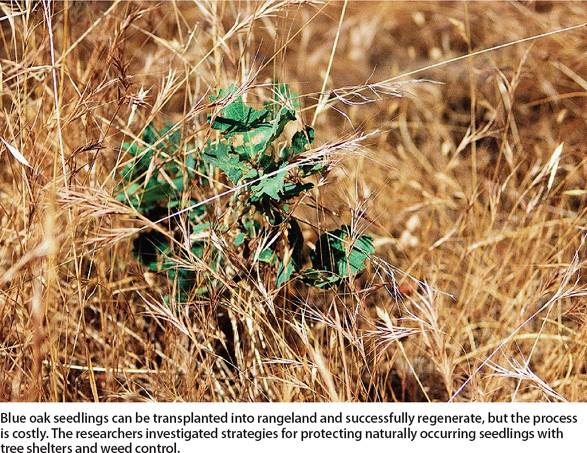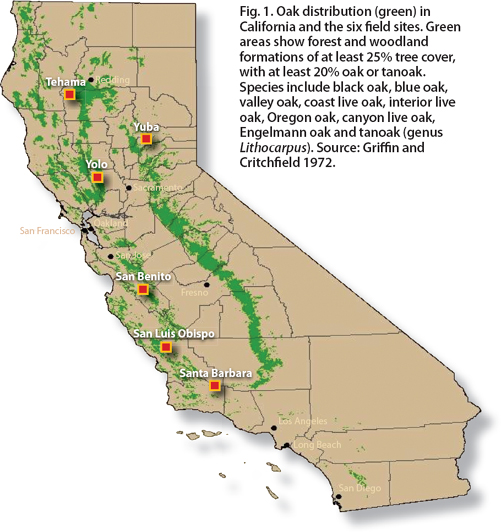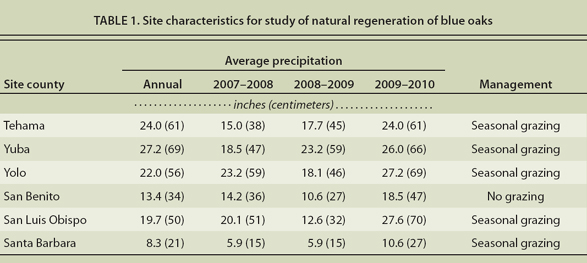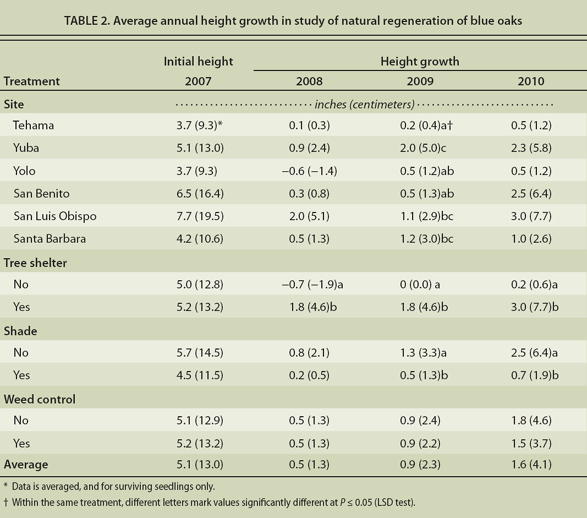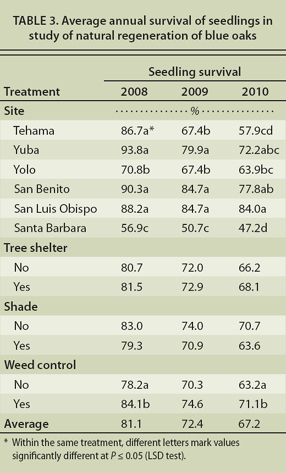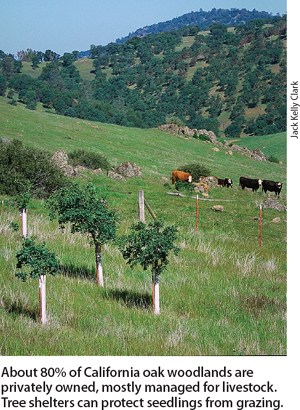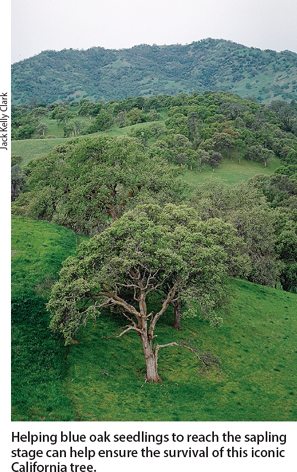All Issues
Tree shelters and weed control enhance growth and survival of natural blue oak seedlings
Publication Information
California Agriculture 65(4):192-196. https://doi.org/10.3733/ca.v065n04p192
Published October 01, 2011
PDF | Citation | Permissions
Abstract
Blue oak is regenerating poorly in portions of its range. Techniques to artificially regenerate trees by collecting acorns, growing seedlings in a nursery and then planting them are effective but costly. Improving the growth and survival rate of existing volunteer seedlings in woodlands could be more cost efficient and therefore more widely used. We tested tree shelters and weed control treatments over 3 years at six woodland sites to evaluate whether they helped blue oak seedlings grow into saplings. The tree shelters enhanced height growth, and weed control improved survival. Together, these two techniques can improve the chances for managing blue oak sustainably and conserving this native California oak for future generations.
Full text
For over a century, there has been concern that several native California oak species are not naturally regenerating adequately to sustain populations (Jepson 1910). Blue oak (Quercus douglasii Hook & Arn.) is one of these species (Bolsinger 1988; Muick and Bartolome 1987). Endemic to California, blue oak distribution extends from the Siskiyou Mountains in the north to the Tehachapi Mountains in the south; however, it grows primarily in the Sierra Nevada foothills and coastal mountain ranges. The majority of the woodlands where blue oak grows are used for grazing and beef cattle production.
Although blue oak is long lived and relatively few seedlings and saplings are needed in any one year to replace mature trees that die, research indicates that in portions of its range this natural regeneration is not occurring. Swiecki et al. (1997) assessed 15 sites representing the broad range of blue oak and reported that the number of saplings at 13 sites was inadequate to offset recent losses in density and canopy cover caused by natural mortality and tree cutting. Even though blue oaks will sprout after their tops are killed by fire or felling (McClaran and Bartolome 1989; Mensing 1992; Standiford et al. 2011), the ability of seedlings to grow into mature trees is essential for the species to sustain itself and prosper.
Blue oak seedlings can be transplanted into rangeland and successfully regenerate, but the process is costly. The researchers investigated strategies for protecting naturally occurring seedlings with tree shelters and weed control.
One theory suggests that the apparent shortage of oak saplings may not signal a regeneration problem but only a lull in natural recruitment, which occurs in spurts, or pulses. These pulses happen when a rare combination of events, such as a wet, late spring following a good acorn crop, combined with, for example, low populations of seedling-eating animals, occurs. The optimal conditions for regeneration may therefore occur only once or twice in a century. For a very long-lived species such as blue oak, these infrequent pulses may be adequate to sustain populations. At present, however, there is little evidence to support this theory, since aging studies of blue oak stands indicate that seedling recruitment occurs over long intervals rather than during short pulses (Kertis et al. 1993; McClaran 1986; Mensing 1992; White 1966).
The reasons for poor regeneration of blue oak vary by site. They include competition from dense annual grasses, browsing by domestic livestock, and herbivory by grasshoppers, squirrels, gophers, voles, rabbits, deer and other animals. Aggravating the situation is the fact that the regions where blue oak grows best have a Mediterranean climate, with a dry period that normally extends from midspring until early fall. Soil conditions can become exceedingly dry, making it difficult for oaks to become established. The bottleneck, or problematic interval in the regeneration process, is from the seedling to the sapling stage (Swiecki et al. 1997). During most years, a sufficient number of acorns germinate, and small seedlings begin to grow in the understory, but few survive to become established saplings. Swiecki et al. (1997) defined saplings as having a diameter at breast height (DBH) between 0.4 and 1.2 inches (1 and 3 centimeters). The low seedling survival rate has resulted in a bimodal size distribution in many blue oak stands, with considerable numbers of seedlings and trees but few saplings.
For over two decades, UC researchers and others have been developing techniques to artificially regenerate California oaks, including blue oak. Research has included collecting, storing and planting acorns; producing oak seedlings in container and bare-root nurseries; and planting and maintaining seedlings in the field (McCreary 2001). Overall, the research demonstrates that sapling-sized oaks can be established artificially — in less than 5 years — but the substantial management required is costly. As a result, these techniques are not being used for large areas.
An alternative oak regeneration strategy is to promote the advancement of naturally occurring seedlings on-site, helping them to reach the sapling stage. This strategy could produce considerable savings because no effort or cost would be expended to collect acorns or to grow and plant seedlings. An additional advantage is that only genetically adapted plant material would be used, alleviating concerns about using off-site planting stock that is not adapted to local conditions. Given these economic, ecologic and genetic advantages, landowners may be more likely to adopt natural regeneration practices than artificial regeneration.
Tests at six seedling sites
To test the strategy of enhancing natural blue oak regeneration, we initiated a study in spring 2007 at six sites broadly representing the range of blue oak in California (fig. 1). The northernmost site was near Red Bluff in Tehama County, and the southernmost site was in Santa Barbara County about 18.6 miles (30 kilometers) west of Cuyama. At each site, 144 naturally occurring blue oak seedlings between about 1 and 23 inches (2 and 58 centimeters) tall were identified and tagged. We selected seedlings on each site such that half were under the canopy of existing trees and half were outside the drip line of the trees and in the open.
Fig. 1. Oak distribution (green) in California and the six field sites. Green areas show forest and woodland formations of at least 25% tree cover, with at least 20% oak or tanoak. Species include black oak, blue oak, valley oak, coast live oak, interior live oak, Oregon oak, canyon live oak, Engelmann oak and tanoak (genus Lithocarpus). Source: Griffin and Critchfield 1972.
Treatments.
The 72 seedlings per canopy treatment at each site were arranged in 18 groups of four seedlings each. Except for a few cases where closely spaced seedlings were difficult to locate, seedlings within each group of four were no closer than 4 feet (1.2 meters) apart and no farther apart than 20 feet (6.2 meters). In spring 2007, one member of each group of four was randomly selected to be covered with a 4-foot (1.2-meter) tree shelter. Tree shelters are solid, double-walled plastic cylinders that are placed over individual seedlings. They were developed in England in the early 1980s and are reported to protect seedlings from browsing and to stimulate aboveground growth (Tuley 1983).
We eliminated the surface vegetation within approximately 2 feet (60 centimeters) of a second seedling in each group by spraying with contact herbicide (glyphosate [Roundup]) and reapplied the herbicide each subsequent spring. We covered the third seedling of each group with a tree shelter and sprayed for weed control. The fourth seedling was a control without protection or weed control.
Data collection.
Before we installed the treatments, we recorded each seedling and its height (distance from the ground to the tip of the highest bud with the seedling held straight). In the falls of 2008, 2009 and 2010, we assessed each seedling for survival and total height. In cases where the top of the seedling had died, we recorded the height from the base to the highest living point as indicated by green foliage or green tissue under the bark. When we found seedlings that had died, we tried to identify the cause (e.g., gopher damage, aboveground herbivory, drought), but this proved difficult so no results are reported here. We collected management history for each site from the landowners and average annual precipitation in the 2007–2008, 2008–2009 and 2009–2010 growing seasons (measured from Oct. 1 to Sept. 30), from local weather databases (table 1).
An alternative oak regeneration strategy is to promote the advancement of naturally occurring seedlings on-site, helping them to reach the sapling stage.
Statistical analysis.
The seedling data was analyzed as a doubly nested randomized block experiment with sites as the main plots, shade as the subplots and factorial combinations of tree shelters and weed control as the sub-sub plots. Before analysis, the data was averaged over shade, shelter and weed control treatments for each site. Differences were considered significant at the P ≤ 0.05 level.
Each response variable (height growth and survival) for each year was tested for significance, as were all two-way interactions. When we found significant differences for the sites, we performed least significance difference (LSD) tests to determine which sites were significantly different from the others (P ≤ 0.05). We also examined all significant two-way interactions to determine their cause. Finally, we computed partial correlations to find out if initial seedling height (measured in 2007) was related to subsequent growth and survival.
Growth and survival differences
Height growth.
Height growth can be critical to the survival of blue oak seedlings, because they are only relatively resistant to browsing damage from cattle, or clipping of the aboveground portion of the seedling, when they reach 6.5 feet (2 meters) (McCreary and George 2005). Without protection, seedlings may languish in a stunted state, due to repeated browsing, for decades (White 1966).
In our study, tree shelters significantly increased seedling height growth at all sites (table 2). However, responses were not consistent over sites, and there were highly significant site/shelter interactions for height growth each year. For instance, at the San Luis Obispo County site, two seedlings in the shelter treatment grew 4 feet (1.2 meters) — to the tops of the shelters — during 2008. This represented an annual height growth of over 2 feet (60 centimeters) for each of these two seedlings. At the Yolo County site, on the other hand, no seedlings grew more than 1.6 inches (4 centimeters) during 2008, and the average change in height for each of the treatments, including the shelter treatment, was negative.
There were also significant shade/shelter interactions for height growth each year, because the positive effects of the tree shelters were much less for seedlings under the canopies than they were for seedlings in the open. Height growth each year was also positively correlated with initial seedling height. Partial correlations, adjusted for site, of initial height and height growth were highly significant each year — the taller the seedlings were initially, the more they grew.
There was much greater height growth in the last year of the study (2010), which corresponded to an above-average rainfall year. Height growth in 2010, averaged over all sites and treatments, was approximately double that in 2009 and more than triple that in 2008. The difference in height growth for sheltered compared with unsheltered seedlings was also greatest in 2010.
Survival.
The differences in survival were less pronounced than they were for height growth, although there were significant site differences in survival every year (table 3). In 2008 and 2010, there were also significant differences in survival for weed control treatments, with seedlings receiving weed control having greater survival than those not receiving it. In 2009, those receiving a weed control treatment had higher average survival, but the differences (P = 0.10) were not significant. The initial size of seedlings was also significantly and positively correlated with subsequent survival.
Tree shelters improved growth
In previous research, tree shelters consistently promoted the height growth of artificially planted blue oak seedlings (Costello et al. 1991; McCreary 1997; McCreary and Tecklin 1997). This accelerated growth results from environmental changes within the tubes — including elevated CO2 levels, increased humidity and higher temperatures — as well as protection that the tubes provide to seedlings from damage by animals. Shelters therefore offer the possibility of allowing seedlings to grow more rapidly to a height where they are relatively resistant to animal impacts. A study at the UC Sierra Foothill Research and Extension Center in Yuba County, near one of the field sites, found that shelters caused dramatic (and significant) increases in seedling height growth (Tecklin et al. 1997). Shelters had been placed over seedlings that were planted 2 years earlier but languished with little growth. Almost immediately, the seedlings began to grow rapidly, and 2 years later average seedling height was nearly 4 feet (1.2 meters). By comparison, the controls grew very little and remained less than 1 foot (30 centimeters) tall.
In our current study, tree shelters also significantly increased height growth, although the increase was not as great as that measured for artificially planted seedlings (McCreary 1997; McCreary and Tecklin 1997). Each year, livestock rubbing caused some shelters to be displaced so that they no longer covered the seedlings when we came to measure them in the fall. This may have contributed to reduced growth, though it was impossible to determine when during the year (or at least when after the spring weed control treatments) this had occurred. But we did observe browsing damage to some of these seedlings before we repositioned the tree shelters over them.
The effects of the tree shelter treatments were not uniform over all sites. Consequently, there were significant interactions in all 3 years for height growth between the shelter treatment and sites. For instance, while 2008 height growth was larger for seedlings in tree shelters at all sites, the magnitude of this difference varied considerably. At the San Luis Obispo site, the shelter treatment resulted in an average height increase of over 2 inches (5 centimeters) in 2008, while at the other sites the enhancement from the shelters was far less dramatic. Furthermore, the effects of tree shelters seemed somewhat dependent on initial seedling size, with larger seedlings benefiting more from the shelters. For example, the regressions of initial seedling height with subsequent height growth each year indicated that these variables were positively, and significantly, correlated.
Impact of other factors
Weed control.
California's hardwood rangelands commonly have dense under-stories of introduced Mediterranean annual grasses (Heady 1977), which compete with oak seedlings for moisture, nutrients and light and can make it difficult for the oak seedlings to grow into saplings (Welker and Menke 1987). Removing this vegetation around the seedlings increases the resources, especially moisture, available for them. It may also reduce damage from voles (Tecklin and McCreary 1993) and grasshoppers. Weed control around artificially planted blue oak seedlings has been shown to enhance their growth and survival (Adams et al. 1997; McCreary and Tecklin 1997). In our study results, the weed control treatment apparently had little effect on height growth (no significant differences were detected), but, importantly, it significantly increased survival in 2 of the 3 years (table 3).
Seedling mortality.
Altogether, 28.2% of the original seedlings died (244 of 864 seedlings). The causes of seedling mortality were difficult to determine. At the Yolo and San Benito county sites, feral hog rooting (foraging in the soil with snouts and tusks) disturbed the soil and eliminated over a dozen seedlings. At the Yuba and Santa Barbara county sites, livestock and deer browsing appeared to reduce seedling height and likely killed some seedlings not in shelters. At all of the sites, there was evidence of browsing of non-sheltered seedlings, and in many cases these seedlings were either killed or lost height during one or more years.
About 80% of California oak woodlands are privately owned, mostly managed for livestock. Tree shelters can protect seedlings from grazing.
At the San Luis Obispo and Yuba county sites, there was extensive gopher activity close to some seedlings, although only a couple of them appeared to be affected. The extremely high mortality at the Santa Barbara County site was most likely due to below-normal rainfall during 2008 and 2009, only 5.9 inches (15 centimeters) each year, compared with the long-term average of 8.3 inches (21 centimeters). Even though blue oak is relatively drought resistant, it is not surprising that mortality was so high under these extremely dry conditions.
Shade.
Whether seedlings were growing in shade (under tree canopies) influenced how they performed. Shaded seedlings grew less, and differences in total height and height growth between shaded and nonshaded treatments were significantly different in 2009 and 2010.
There were significant interactions for shade and shelter for height growth in all years — seedlings in tree shelters did not grow as much in shade as did those in the open. This is not surprising since tree shelters reduce light levels reaching the seedlings inside, often by 50% or more (Devine and Harrington 2008). In our study, light levels for seedlings in tree shelters in the shade were apparently too low to allow substantial growth.
Seedling size.
The height of the seedlings initially, at the start of the study, was strongly and positively correlated with how much the seedlings subsequently grew. It was also significantly positively correlated with survival. Taller seedlings have more biomass and photo synthetic tissue and would be expected to grow more; for regeneration, they are the best candidates for protection or weed control.
Helping blue oak seedlings to reach the sapling stage can help ensure the survival of this iconic California tree.
Rainfall.
This study took place during 3 consecutive relatively dry years (including 2007, the year the plots were established), followed by one average or above-average rainfall year. We cannot say for certain that the large increase in 2010 seedling height growth compared to the previous 2 years’ growth was primarily due to increased rain, but it appeared that more soil moisture contributed to greater growth. For instance, we noticed more seedlings exhibiting second flushing — a second period of active shoot elongation — in 2010 than in previous years. The positive effects of the shelter treatments were also greatest in 2010, suggesting that tree shelters are most beneficial when there is abundant moisture.
Improved regeneration
Our study has been under way for less than 4 years — a relatively short time in the life of blue oaks — but the data strongly suggests that tree shelters can enhance growth and that weed control can increase survival. Both techniques improved the chances for blue oak seedlings to grow into saplings. These trends were especially evident in the last year of the study, when annual precipitation was above average at most sites, and seedlings growing away from tree canopies and in full or near-full sunlight had the maximum benefit.
In our experience, blue oak seedlings in the open covered with tree shelters generally grow into saplings in less than a decade. Compared with artificial regeneration techniques, this natural regeneration strategy is more cost efficient and therefore more likely to be widely adopted by California landowners. We estimate that this approach would cost less than half of what it costs to plant seedlings. We feel that using tree shelters and weed control to enhance early growth and survival of naturally occurring blue oak seedlings could significantly improve the regeneration of this important woodland species and promote its long-term conservation.



